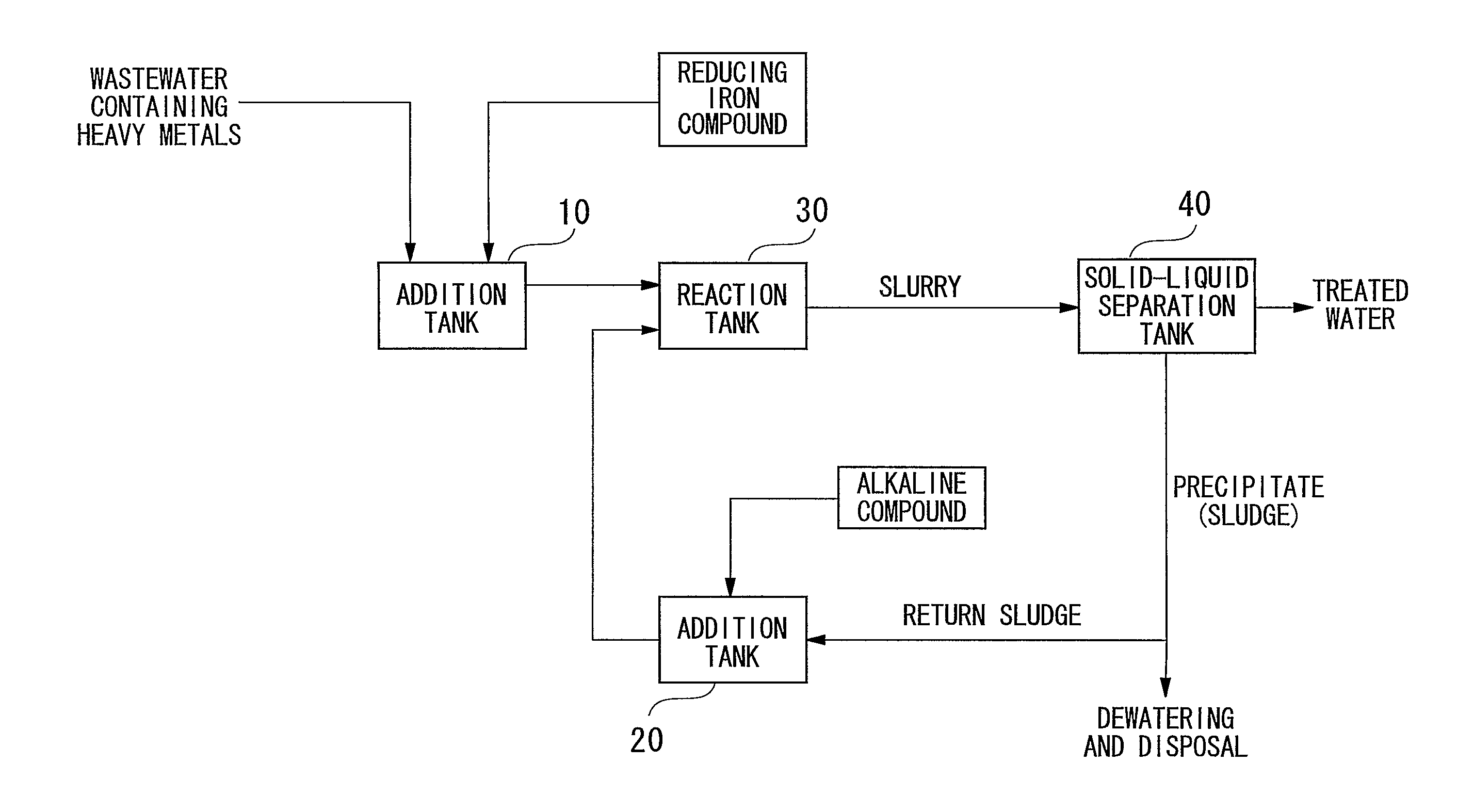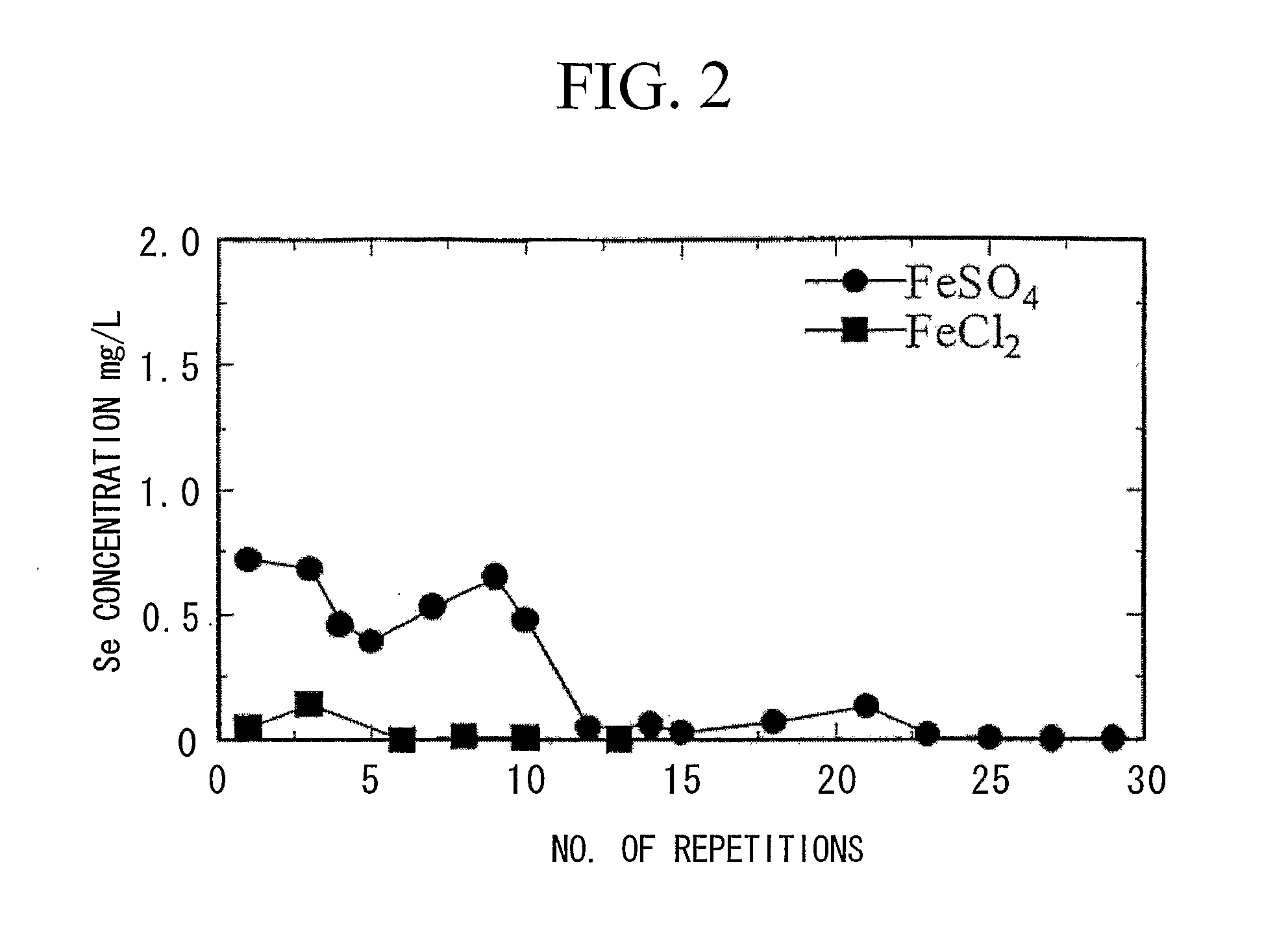Reducing water purification material, method for producing reducing water purification material, method for treating wastewater, and wastewater treatment apparatus
a technology for water purification and wastewater treatment, applied in the field of water purification materials, can solve the problems of imposing a large burden on the apparatus structure, affecting the quality of water purification, and affecting the quality of water purification, and achieves superior economic and treatment effects, and satisfactory solid separation.
- Summary
- Abstract
- Description
- Claims
- Application Information
AI Technical Summary
Benefits of technology
Problems solved by technology
Method used
Image
Examples
example 1
[0102] Wastewater containing heavy metals was treated in the manner described below using a batch system in accordance with the flow chart showing an example of the treatment process of the present invention shown in FIG. 1. First, 2.0 L of wastewater containing contaminants (heavy metal concentrations: 2 mg / L each) were led into the addition tank 10 followed by the addition of ferrous sulfate to an Fe(II) concentration of 600 mg / L. On the other hand, the entire amount of separated precipitate was returned to the alkaline compound addition tank 20 followed by the addition of 1.5 g of calcium hydroxide to adjust to a strongly alkaline pH of 12. This strongly alkaline precipitate was returned to the reaction tank, mixed with wastewater to which was added ferrous sulfate and allowed to react for 2 hours. Next, slurry extracted from the reaction tank was separated into solid and liquid by causing the precipitate to settle by allowing to settle undisturbed for 20 hours in a thickener. Th...
example 4
[0105] Aqueous ferric chloride solution was added to a concentration of 1.0 ml / L to 2 L of simulated wastewater containing 100 ppm each of silicate ions and aluminum ions as well as 2 ppm of selenium. The pH of the wastewater was then adjusted to 8 to 8.5 by addition of an alkaline compound to form a precipitate. After separating this precipitate by filtration, the filtrate was treated in the same manner as Example 1.
[0106] On the other hand, results obtained by carrying out treatment in the same manner as Example 1 without carrying out this pretreatment are shown in Table 2 for comparison.
[0107] As shown in Table 2, in wastewater in which the concentrations of aluminum ions and silicate ions were reduced to 1 ppm and 15 ppm, respectively, by carrying out pretreatment, the concentration of selenium was reduced to less than 0.01 ppm as a result of ferrite conversion treatment, and since ferrite conversion was allowed to proceed adequately, high removal effects were achieved.
[0108]...
example 5
[0109] Aqueous ferric chloride solution was added to a concentration of 1.0 ml / L to 2 L of simulated wastewater containing 50 ppm of traces of organic compounds (TOC) and 2 ppm of selenium followed by the addition of an alkaline compound to adjust the pH of the wastewater to 8 to 8.5 and form a precipitate. The precipitate was separated by filtration and the TOC concentration of the wastewater decreased to 20 ppm or less. This filtrate was treated in the same manner as Example 1.
[0110] On the other hand, results obtained by carrying out treatment in the same manner as Example 1 without carrying out this pretreatment are shown in Table 3 for comparison.
[0111] As shown in Table 3, wastewater subjected to pretreatment demonstrated a low concentration of selenium, a volume ratio of concentrated sludge was 20%, the sludge was strongly magnetic, and ferrite conversion proceeded adequately.
[0112] On the other hand, wastewater not subjected to pretreatment demonstrated a somewhat high se...
PUM
| Property | Measurement | Unit |
|---|---|---|
| Temperature | aaaaa | aaaaa |
| Temperature | aaaaa | aaaaa |
| Time | aaaaa | aaaaa |
Abstract
Description
Claims
Application Information
 Login to View More
Login to View More - R&D
- Intellectual Property
- Life Sciences
- Materials
- Tech Scout
- Unparalleled Data Quality
- Higher Quality Content
- 60% Fewer Hallucinations
Browse by: Latest US Patents, China's latest patents, Technical Efficacy Thesaurus, Application Domain, Technology Topic, Popular Technical Reports.
© 2025 PatSnap. All rights reserved.Legal|Privacy policy|Modern Slavery Act Transparency Statement|Sitemap|About US| Contact US: help@patsnap.com



